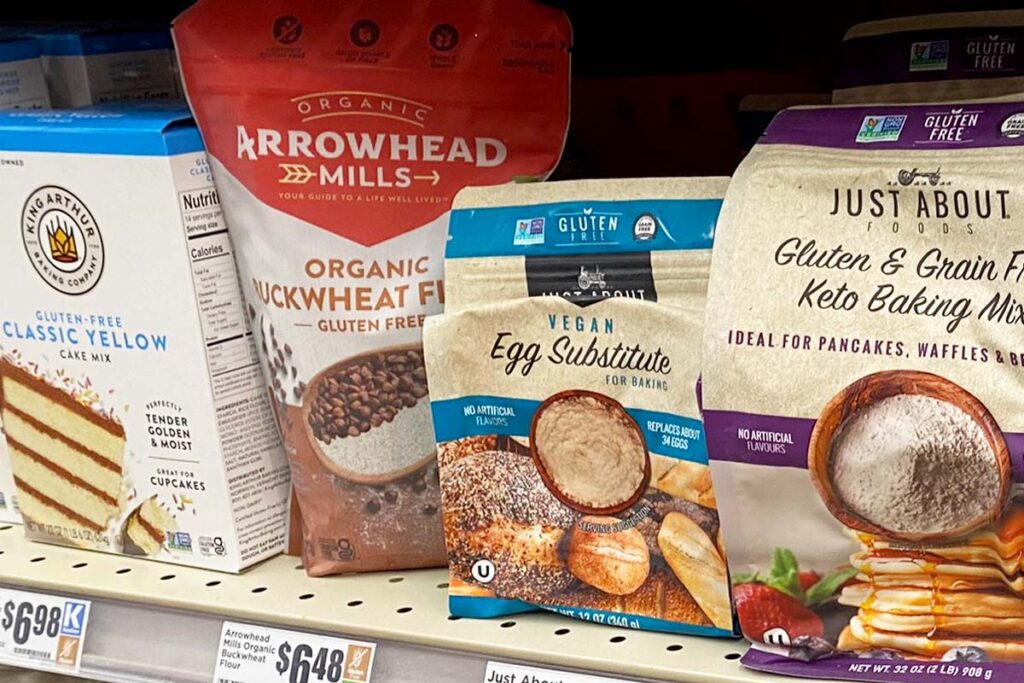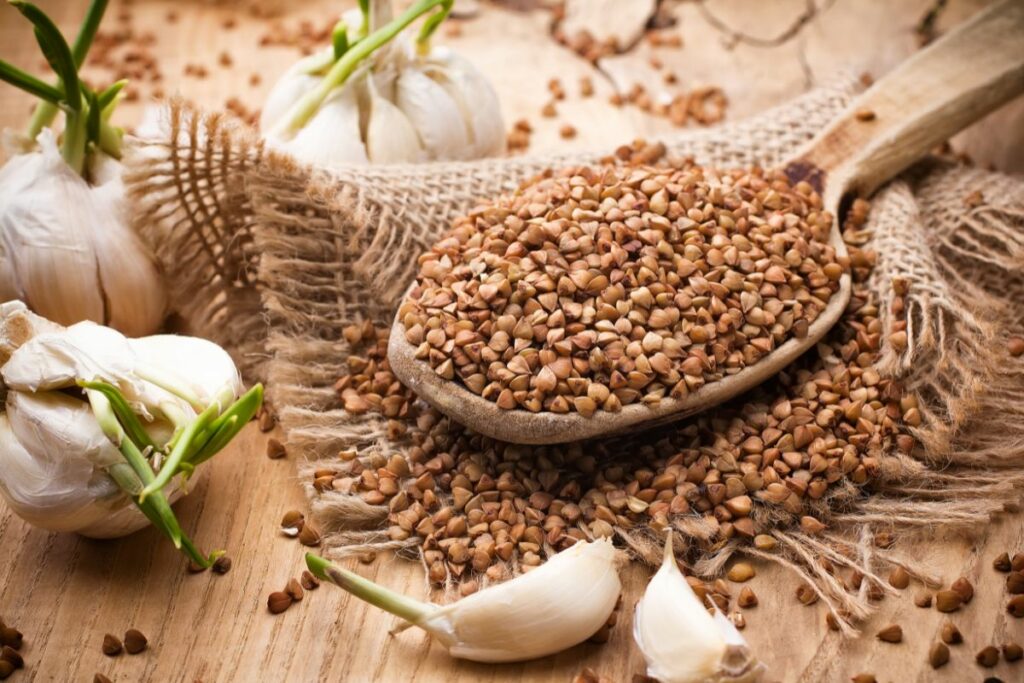Though Buckwheat is certainly one of the lesser known healthy grains out there, it’s been gaining popularity as it’s naturally gluten-free. I even saw it on the shelf of my local H-E-B (a Texas-based grocery store) in the form of Buckwheat flour, which is commonly used to make Buckwheat pancakes.
If you’re new to Buckwheat or whole grains in general, you may be surprised at how different each grain can be (you can check out my comparison chart here to help you navigate the world of whole grains) which means each grain effects your body in different ways.
The good news is that Buckwheat is generally considered to be a non-bloating and easily digestible food for most people so it does not typically cause bloating. Even though it’s called Buckwheat it’s actually not a grain, but a pseudo-grain (a non-grain that acts like one). It’s naturally gluten-free and doesn’t contain the proteins that can cause digestive issues for some individuals, like those found in wheat, barley, and rye.
What is Buckwheat?
Buckwheat is a type of flowering plant that comes directly from the knotweed family Polygonaceae.

It is typically cultivated due to its grain seeds and is a common cover crop used by farmers. While its grains can be incorporated into cereal, Buckwheat is most commonly used as a flour. You’ll typically find it as:
- Whole or un-hulled (black in color) which is milled to make “Buckwheat Flour”
- Hulled, which is raw and can be sprouted (tan with a light-green tint) and is sold as “Buckwheat Groats”
- Kasha, which is toasted (cooked) and cannot be sprouted (light brown in color) and is sold as “Buckwheat Kasha”
Buckwheat is considered heart healthy and is incredibly rich in minerals, nutrients and vitamins. Let’s break down the main nutrients that can be found in buckwheat below:
- Copper: Copper is a vital trace element that many people have a deficiency in. Even when eaten in very small amounts, copper is known to be able to help contribute to and support the healthy functioning of the heart, as well as the body and mind in general
- Iron: Buckwheat is also filled with iron! Iron is a vital mineral that we all need. Without healthy levels of iron, it can lead to conditions such as anemia which can lead to the blood becoming compromised and unable to carry healthy levels of oxygen throughout the body
- Phosphorus: Unlike other types of healthy grains out there, Buckwheat is also extremely high in phosphorus! Phosphorus is another mineral that many people find themselves experiencing a deficiency in, which is why eating Buckwheat can offer so many benefits. Phosphorus is essential in the healthy maintenance of the body tissues and can even help to contribute to the healthy functioning of the body and the mind overall
Nutritional Information for Whole Grain Buckwheat (per 100 grams)
It’s important to understand the nutrition of buckwheat to see if it’s a good fit for you:
| Nutrient | Amount |
|---|---|
| Calories | 343 kcal |
| Total Fat | 3.4 g |
| – Saturated Fat | 0.7 g |
| – Monounsaturated Fat | 1 g |
| – Polyunsaturated Fat | 1 g |
| Cholesterol | 0 mg |
| Sodium | 1 mg |
| Total Carbohydrates | 71.5 g |
| – Dietary Fiber | 10 g |
| – Sugars | 2.6 g |
| Protein | 13.25 g |
| Vitamin D | 0 IU |
| Calcium | 18 mg |
| Iron | 2.2 mg |
| Potassium | 460 mg |
| Magnesium | 231 mg |
| Phosphorus | 347 mg |
| Zinc | 2.4 mg |
| Copper | 0.4 mg |
| Manganese | 1.3 mg |
| Selenium | 8.3 mcg |
| Thiamin (Vitamin B1) | 0.1 mg |
| Riboflavin (Vitamin B2) | 0.4 mg |
| Niacin (Vitamin B3) | 7 mg |
| Vitamin B6 | 0.2 mg |
| Folate (Vitamin B9) | 30 mcg |
| Vitamin K | 1.9 mcg |
| Vitamin E | 1 mg |
Tips to minimize bloating from Buckwheat
The good news is that Buckwheat is gluten-free, which means it’s usually well tolerated by people who have Celiac Disease or gluten sensitivities.
To make sure you’re getting the most out of Buckwheat, here are a few tips I’ve picked up over the years:
Tip #1: Use the right kind of Buckwheat

As I mentioned above, think of Buckwheat like a triangular-shaped sunflower seed. The outer “shell” (or hull) is black whereas the inside is a light tan “meat.”
If you’re looking for Buckwheat Flour, it would be ground from the entire whole Buckwheat, which includes the hull. If you’re wanting a Buckwheat hot cereal, similar to oatmeal, then make sure you get Buckwheat Groats or Buckwheat Kasha.
Depending on what you’d like to make, you’ll want to get either hulled or un-hulled, roasted or un-roasted. The right type of Buckwheat matters and here are a few dont’s:
- Mill whole Buckwheat in a home mill: Don’t do this! More than likely it will break your mill because Buckwheat hulls are very hard. Instead, try a blender or a coffee grinder. You’ll need to use a steel blade grinder or try sourcing commercial Buckwheat flour
- Use whole Buckwheat in a hot cereal: Don’t do this! No amount of cooking can get the hull to soften like oatmeal. Make sure you’re using Groats or Kasha if you want to eat Buckwheat as a hot cereal
Tip #2: Be aware of it’s fiber
Buckwheat flour typically tends to contain around 3 grams of fiber per a quarter cup, which is AWESOME for most people and one of the reasons why I love whole grains. But, this high concentration of fiber can potentially cause cramping and gas in those who are already predisposed to fiber sensitivities.
If you are sensitive to high-fiber foods, take Buckwheat’s high-fiber into account and ensure you’re balancing your meal with protein and fats.
Tip #3: Don’t undercook Buckwheat Groats
If you’ve had trouble with Buckwheat Groats or Kasha, you might have undercooked them which can cause your stomach to get a bit unhappy.
As a rule of thumb, I typically follow a 1 to 2 ratio of Groats to liquid:
- 1 cup Buckwheat Groats
- 2 cups water or milk
- Pinch of salt (optional)
A few tips when cooking Buckwheat Groats:
- Make sure you bring it to a boil: When you combine the Groats and liquid, make sure you bring the mixture to a boil over medium-to-almost-high heat. If your liquid doesn’t get hot enough it won’t cook through
- Simmer it long enough: Simmer for at least 15-20 minutes, maybe even 25-30 minutes depending on your preferences and where you sourced your grains (Remember, Buckwheat is from nature and every region and every farmer can have slightly different grains!)
- Stir every few minutes: Occasionally stir the groats while they’re simmering to prevent sticking to the bottom of the pan. This also allows you to add more liquid if they need it, allowing the Groats to cook all the way through
The bottom line: Should you eat Buckwheat?

Whether Buckwheat causes you stomach pain or bloating will be a personal journey for you, but the good news is that it more than likely won’t cause stomach pain, especially for those with a gluten sensitivity or Celiac Disease since it’s a gluten-free pseudo-grain.
Just make sure you are choosing the right type of Buckwheat for what you’re wanting to make, be aware of it’s high-fiber content, and make sure you aren’t undercooking it as your body can definitely complain if the Buckwheat seeds are too hard to digest.
However, if you are struggling to get enough fiber in your diet and you need to take more of it, Buckwheat can help to regulate your digestive system while also helping to reduce the chances of you experiencing constipation.
I go more into Buckwheat in my Buckwheat: Complete guide to a gluten-free grain article here.








